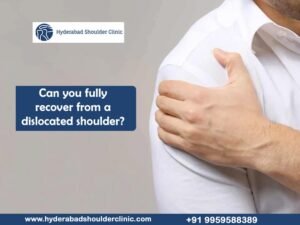Reverse total shoulder replacements are being used to treat a variety of conditions. Patients with end-stage shoulder arthritis, a large irreparable rotator cuff rupture, a complicated shoulder injury, or failed shoulder replacement fall into this category.
A reverse shoulder replacement requires a specific implant that replaces the socket ( glenoid ) with a metal ball and the humerus head( ball ) with a socket. As a result, “Reverse” Total Shoulder Arthroplasty was coined. The rotator cuff muscles are not required to use the arm with this type of replacement. The main muscles that play a major role in moving the arm are the deltoid and pectoralis muscles.
Why might I need a reverse total shoulder replacement?
If you suffer from severe pain that interferes with your daily activities, surgery may be an option. Surgery might also be suggested in case of shoulder weakness and when you lose full range of motion. Surgery may also be recommended if other treatments do not work. These may include medicines, shots (injections), and physical therapy.

The majority of people typically have a total shoulder replacement. However, reverse total shoulder replacement is more effective for those who have certain shoulder problems, including rotator cuff tears. If you suffer from this type of injury, a regular shoulder replacement may still cause discomfort and limit your movement. These issues can be alleviated with a reverse total shoulder replacement. The deltoid muscle comes into play in place of the rotator cuff surgery. This important muscle helps do certain functions, like lifting your arm up and away from the body.
Healthcare professionals may also recommend surgery to people who have already had a standard shoulder replacement for osteoarthritis or other reasons. These patients still carry the symptoms that can be fixed by a reverse total shoulder replacement.
Doctors say that in some rare cases, people have shoulder problems even after traditional shoulder replacement surgery for osteoarthritis and other reasons. So they recommend undergoing reverse total shoulder replacement as it can still resolve these symptoms.
During a reverse total shoulder replacement
Your doctor will go over the specifics of your procedure with you. An orthopaedic surgeon will perform the surgery, and a team of experts will assist him. It will take many hours to complete the whole procedure. Below is what you can expect:
- You will likely be sedated, putting you to sleep during the procedure.
- You may also be given an injection that numbs your shoulder nerves. This is called local anaesthesia, used in some cases instead of general anaesthesia.
- The surgeon will monitor your vital signs carefully throughout the whole procedure.
- The surgeon will cut the upper part of your shoulder. The cut is made in such a way as to get access to the damaged area.
- The damaged portion of the humerus and the scapula will be removed during the surgery. Then the metal ball will be attached to your scapula with the help of special screws, and the plastic socket will be mounted on the top of your upper arm bone.

- Extra fluid might be drained from the joint with a tube, which will be removed later.
- Surgical stitches or staples will be used to close the incision after your surgeon inserts the new joint.
Remember that pain is part of the healing process. However, your shoulder pain problem will decrease. Follow the surgeon’s instructions about the care you need to take to recover from shoulder surgery. The doctor will let you know when you can fully use your hand and arm.
Don’t miss the follow-up appointments (Call Us For Consultation +91-9885298383) with the surgeon. You can improve your chances for a successful outcome by staying in close contact with your provider. An artificial joint will typically last for several years before requiring replacement.





